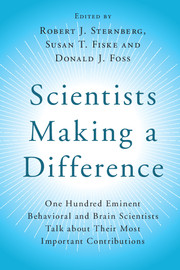 Scientists Making a Difference
Scientists Making a Difference Book contents
- Frontmatter
- Contents
- List of Contributors
- Foreword: Making a Creative Difference = Person × Environment
- Preface
- Part I Introduction
- Part II Biological Bases of Psychology: Genes, Brain, and Beyond
- Section A Feelings, Fears, Stressors, and Coping
- Section B Cognitive and Social Neuroscience
- 9 Social Neuroscience
- 10 Modulating Memory Consolidation
- 11 Memory Consolidation and Transformation: The Hippocampus and Mental Time Travel
- 12 Imaging the Human Brain
- 13 Different Mechanisms of Cognitive Flexibility Within the Prefrontal Cortex
- 14 Memory and Brain
- Section C Behavioral and Molecular Genetics
- Part III Cognition: Getting Information from the World and Dealing with It
- Part IV Development: How We Change Over Time
- Part V Motivation and Emotion: How We Feel and What We Do
- Part VI Social and Personality Processes: Who We Are and How We Interact
- Part VII Clinical and Health Psychology: Making Lives Better
- Part VIII Conclusion
- Afterword: Doing Psychology 24×7 and Why It Matters
- Index
- References
13 - Different Mechanisms of Cognitive Flexibility Within the Prefrontal Cortex
from Section B - Cognitive and Social Neuroscience
Published online by Cambridge University Press: 05 August 2016
- Frontmatter
- Contents
- List of Contributors
- Foreword: Making a Creative Difference = Person × Environment
- Preface
- Part I Introduction
- Part II Biological Bases of Psychology: Genes, Brain, and Beyond
- Section A Feelings, Fears, Stressors, and Coping
- Section B Cognitive and Social Neuroscience
- 9 Social Neuroscience
- 10 Modulating Memory Consolidation
- 11 Memory Consolidation and Transformation: The Hippocampus and Mental Time Travel
- 12 Imaging the Human Brain
- 13 Different Mechanisms of Cognitive Flexibility Within the Prefrontal Cortex
- 14 Memory and Brain
- Section C Behavioral and Molecular Genetics
- Part III Cognition: Getting Information from the World and Dealing with It
- Part IV Development: How We Change Over Time
- Part V Motivation and Emotion: How We Feel and What We Do
- Part VI Social and Personality Processes: Who We Are and How We Interact
- Part VII Clinical and Health Psychology: Making Lives Better
- Part VIII Conclusion
- Afterword: Doing Psychology 24×7 and Why It Matters
- Index
- References
Summary
My significant contribution arose from a simple and perhaps naïve question about localization of function within the primate prefrontal cortex (PFC). Ever since Brenda Milner's seminal discovery about the problems of patients with frontal lobe damage in performing a “test of cognitive flexibility” (Grant and Berg's Wisconsin Card-Sorting Test; WCST), my colleagues and I had debated WCST's precise neural basis. Following analysis of effects of variable lesions suffered by frontal patients, Milner thought that the dorsolateral PFC was the key zone, whereas lots of extant theory about the role of the PFC in behavioral inhibition favored a more ventral region: the orbitofrontal cortex (OFC).
We can classify the WCST either as a test of concept formation or as a trial-and-error rule-learning task. A clinical neuropsychologist tests patients with a pack of 128 cards, each of which varies with respect to three perceptual dimensions: color, shape, and number (of shapes). The neuropsychologist provides spoken feedback for card-sorting according to three possible “rules”: color, shape, or number. Once a patient has learned the rule, the rule changes without warning, and they have to suppress the just-learned “rule” and learn another instead. Patients with frontal lobe damage perseverate with the former rule, even though they are apparently aware that it is wrong.
To address the issue of neural localization we modified the task for non-human primates, as the WCST essentially exemplified a paradigm well known in animal learning theory and developmental psychology. For complex (“compound”) stimuli comprising multiple dimensions, we make a distinction between learning to generalize a rule across different exemplars of a dimension, such as circles to squares (intra-dimensional shift [ids]; also known as “learning set”), and extra-dimensional shifts (eds) where the subject learns to respond to an alternative perceptual dimension, e.g., color, after attending to shape – similar to the shift in WCST rules. This distinction was important to learning theory in the 1970s, developed by Mackintosh and Sutherland, because a comparison of learning these two shifts predicts that the former, within-dimensional shift, will be easier according to their theory of attentional learning.
However, our non-human primate, the New World marmoset, could not be expected to sort cards (or indeed reliably perceive colors or numbers), so we adapted the test for use on a touch-sensitive screen with computer-controlled stimuli, using perceptual dimensions of lines and shapes.
- Type
- Chapter
- Information
- Scientists Making a DifferenceOne Hundred Eminent Behavioral and Brain Scientists Talk about Their Most Important Contributions, pp. 62 - 65Publisher: Cambridge University PressPrint publication year: 2016
